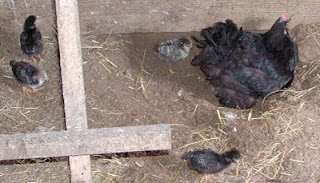The GOOD:
The last set of the incubator came off... and I was resigned to the fact that here was yet another batch of chicks I would have to raise without the help of a mama hen!!! They stayed under a light in the porch for four or five days, simply because the older batch of chicks were still in the little pen that was the usual 'first brooder'.
One morning, while milking, I realized I had been seeing a speckled hen in the barn for several mornings... I expected her to have come in the open door, as many do. But today, I had closed the door immediately behind myself. The hen came out to the cat milk pan and wandered around... soon, it dawned on me, she was acting like a setting hen does... out for her stretch, bathroom break, and a bit of food!!!
I watched her carefully, and from behind the cow... and soon saw her disappear in the west corner of the barn. That night, I did a little exploring, and found her sitting on a nest of 28 eggs!!! I candled them and either they were just started or were not going to be good. I think she had just begun remaining with them that night, although I remember seeing her in the barn many days in the past. I had the great idea to give her my incubator chicks, even though this 'grafting' often doesn't work with a hen that hasn't set on a nest with eggs at least a week!
The next night, I slid a chick under her, and the next morning, I gave her one or two every couple of hours.
After noon, I took the rest to the little brooding pen, and then gathered her and the 6 that she had... and put all the chicks together, and set her in with them.
For the next twenty minutes, I watched, and soon began to worry. She was still acting like a setting hen going for her stretch and activities! She wandered all around the little pen, then slowly jumped over the front board, walked past me and began to explore all corners of the little shed. Soon however, she came back, took a few good looks at me, and jumped back in with the chicks. She stood and stared at them, still and silent for about 5 minutes, then picked up a bit of 'chick mash' and dropped it and began to break it up with her beak. I knew then it would probably all work out.
However, the chicks had to learn to be with a mama, every bit as much as she had to get used to the idea that she suddenly had 23 chicks!!! They had not been used to going under a hen!
Later that night, as it was cooling off, 2/3rds of the chicks were huddled in a corner, some distance from the hen. I waved my hand over them, trying to get them to peep, move, run to her, or something. They were used to me, from being in the porch, and didn't move. Soon, the hen couldn't stand it any longer, lifted up a few inches, shuffled over to the big huddle of chicks and just sat down on them!!! Then she gave me the 'stay away, they are mine' look. I knew then it was going to be okay!
Here is the GOOD hen:
Now to the BAD:
I ordered bantam chicks from a hatchery, planning to put them under a setting hen due to hatch that same week. I had four eggs under her, and she hatched 2, so added 11 bantam chicks to her brood.
She was an okay mama, but not very vocal. In about two weeks, she stopped clucking to them at all, and at three weeks, she laid several eggs. I had them in a small coop and locked into an attached run, so she couldn't have left even if she had truly wished. But when I moved them to a little pen close to the main coop, she flew over the fence and left... and didn't want back. I had to move the bantams into the feed room of the main coop, because of the gnat problem, and so I put her back with them for the first night, to keep them calmer. She wasn't mean to them, but she surely didn't want to be bothered with them either! Today, I put a band on her leg, and let her go back to the main bunch. The chicks are 6 weeks old and I will keep them protected, so they can go on their own!
Here is the BAD hen:
Last, the Ugly:
My sisterinlaw loaned me a setting hen, a few days before one of our hatchery orders was due to arrive. I have done this 'grafting' of chicks onto a foster mama many times, but this time the hen just would not leave her nest! She loved those eggs, and didn't want a 'ready-made family'!!! So, I put eggs under her and let her work for her kids!!! She came off last week, and is a very good mama to her 7 chicks!
But she had set at my sisterinlaw's coop for about two weeks before I brought her home, and she sat for another week while I tried to get her to take the hatchery chicks... PLUS, she then sat for three weeks on the eggs! So, she had been setting twice as long as usual... and she does look like a bedraggled mama!!!
Here is the UGLY Hen:











